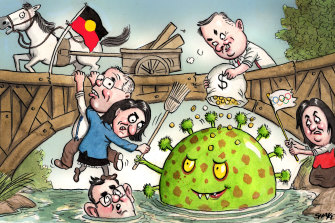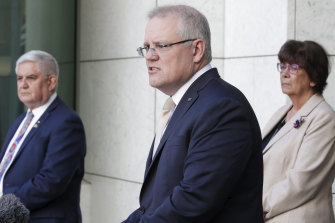Australia at its best and worst
It was the best of politics, it was the worst of politics. This week Australia saw both. The uplifting and the depressing.
In one field of national policy we saw an impressive case study in intelligent, inclusive, unifying politics. It was politics as problem solving. It was the relaunch of Australia’s effort to move its Indigenous people out of Third World living conditions and to join the rest of the population enjoying First World standards. Otherwise known as Closing the Gap.

Illustration: John ShakespeareCredit:The Sydney Morning Herald
In another field, we saw an ugly example of petty, mean-spirited, divisive politics. It was politics as parlour games. It was the Parliament’s approach to the pandemic.
The main headlines announcing the new Closing the Gap plan focused on the federal reparations to be paid to survivors of the ghastly Stolen Generations experience. While this was important, it was only one part of a much bigger ambition unveiled by Scott Morrison.
The redress scheme is a $380 million federal government mechanism. It will give each eligible survivor in a federal jurisdiction a personal apology from a senior federal official, a one-off $75,000 payment in recognition of harms caused by forced removal from family, plus $7000 to pay for healing needs.
But beyond redress for that past injustice, the larger purpose of this week’s plan is “to improve life outcomes for Aboriginal and Torres Strait Islands people across the country†for years to come, in the words of Pat Turner, the convenor of the Coalition of Peaks, representing 51 Aboriginal community-controlled bodies and one of the prime movers behind the plan.
In other words, it’s about the future. The Morrison government allocated $1 billion in new spending for the total package, including the redress scheme. The new Closing the Gap agreement has 17 specific targets for life expectancy, health, education, incarceration and so on. But the old agreement also had targets. They weren’t on track to be met. The new deal stands a much better chance because, for the first time, every aspect is to be co-managed with Indigenous communities themselves.
“Governments said that sort of stuff for a long time, but they never did†include Aboriginal people with any real control over programs, says Turner.
Why was this impressive? For four reasons. First, it represented a humble acknowledgement by the Prime Minister that the existing program was failing. Second, it was a well-intentioned commitment to try to fix the problem. Third, instead of the earlier patronising approach to the needs of Indigenous Australia, the new Closing the Gap agreement is truly a partnership.
“We weren’t at the table guiding government reforms, so I said, ‘Bugger this â€" you can’t keep doing Aboriginal and Torres Strait Islander work without us because it has no impact’,†Turner says.
She prevailed on Morrison to forge an equal partnership. Between the federal government and the Council of Peaks, they managed to persuade the states and territories to include peak Indigenous organisations in every aspect of the new deal. Local governments were brought into the system too.
One critical result: Above the 17 specific targets for improving Aboriginal living conditions sit four “priority reformsâ€. These four create the capacity to deliver the 17 targets.
The four? One. A shared decision-making partnership with Aboriginal and Torres Strait Islander people at every level. Two. Building and strengthening Aboriginal-controlled organisations to deliver services. Three. Government institutions such as the police and judiciary to rid themselves of racists. Four. The sharing of data with the Australian people.

Minister for Indigenous Australians Ken Wyatt, Prime Minister Scott Morrison and Pat Turner, chief executive of the National Aboriginal Community Controlled Health Organisation on Thursday. Credit: Alex Ellinghausen
The principle of power sharing is enshrined in the structure of the new Joint Council that is to run the Closing the Gap program. The council is co-chaired by Turner representing the 51 peak organisations and the federal Minister for Indigenous Australians, Ken Wyatt, himself Indigenous. It met on Friday to consider implementation plans presented by the states.
Turner gives an example of how the equal partnership influenced the setting of the 17 targets: “The previous target aimed to get every child from the age of four enrolled in preschool. We said, ‘We are not interested in how many are enrolled â€" we want to know how many from the age of three are actually attending. Who’s getting an education and who’s not?’â€
The new creation is impressive for a fourth reason â€" although Morrison gets primary credit as the indispensable co-creator and enabler, the overall set-up is bipartisan. Turner explains: “I’ve always said to the Minister and the Prime Minister, ‘You need to have bipartisanship on this. You need Labor at the table.’â€
Federal Labor has indeed signed up to support the program. Turner describes the whole thing as “a turning point as a result of this partnership, which is unique in working with any community as far as I knowâ€.
Contrast this with Parliament’s approach to the pandemic this week. With all governments straining to improve the pace of inoculation against COVID-19, the Labor leader, Anthony Albanese, made a proposal to help push it along: that the federal government consider paying $300 to everyone who gets themselves fully vaccinated. The total cost was estimated at $6 billion. That was it. Simple, practical and constructive.
“This is something that we need to do,†Albanese said. “We need to get our vaccination rates up; we are running last in the developed world. This would be good for our health, but also would provide a much-needed stimulus at a time when workers and small businesses are really struggling to get by.â€
The Prime Minister’s reaction was volcanic. “This is a bad idea,†he told the Parliament. “The Leader of the Opposition’s proposal is a vote of no confidence and an insult to Australians,†he said in increasingly strident tones. “Suggesting they won’t get vaccinated unless you dole out the cash ... that is an insult.†And: “The leader of the Labor Party might think that Australians need to get the cash to get vaccinated, but I think a lot more highly of the Australian people than he does.†Morrison also accused Albanese of profligacy, calling the idea “a cash splash for jabsâ€.
Awkwardly for Morrison, the man he’d appointed in June to fix the vaccine rollout, Lieutenant-General John Frewen, Co-ordinator-General of the National COVID Vaccine Taskforce, made the response that the Prime Minister himself should have made: “We will look at all positive alternatives. There is cash, there is the ideas of lotteries, all these things are being discussed.â€
Morrison had many options for dealing with Labor’s idea. If he’d managed the same attitude that he’d taken to Closing the Gap, he would have humbly acknowledged that the situation wasn’t perfect, said he’d welcome any constructive ideas, and invited Labor to meet to discuss options. He’d have been inclusive and bipartisan. He would have looked like he cared about the public health outcome rather than defending his own political vanity.
This is a recurring theme in Morrison’s political instincts. When confronted with a problem or circumstance that might require him to change his plans or adjust his agenda, he commonly goes into denial. When Australia was burning in its season of fire, he refused to accept leadership and went on holiday to Hawaii. When a cascade of sexual offences against women moved more than 100,000 to march for justice, Morrison initially dodged the role of national leader and refused to meet the women’s rally at Parliament House. When Labor offers constructive ideas for dealing with a pandemic, Morrison immediately rules them out.
This week’s idea wasn’t the first time. In the early phase of the pandemic Labor first proposed a federal wage subsidy. Morrison dismissed it as a “dangerous ideaâ€. Ultimately he adopted it and JobKeeper was born. Labor has made other useful suggestions, too. A year ago it urged the government to order five or six types of vaccine instead of three or four, for instance. Sadly, Morrison’s political vanity deludes him into thinking that he has a monopoly on good ideas.
We know that cash payments can be useful incentives. Just ask Peter Costello about the baby bonus, for instance. Or ask Pat Turner about the cash payments that the Central Land Council offered its staff to get vaccinated against COVID. Did it work? “Bloody oath â€" they’re all vaccinated.â€
As the Closing the Gap experience shows, Morrison in particular and Australian politics in general has the capacity to be great, yet this week also exposes a proclivity to be petty.
In Charles Dickens’ famous opening to A Tale of Two Cities â€" “It was the best of times, it was the worst of time†â€" he continued: “it was the spring of hope, it was the winter of despairâ€.
Peter Hartcher is political editor and international editor of The Sydney Morning Herald and The Age.
0 Response to "Australia at its best and worst"
Post a Comment